Paper Menu >>
Journal Menu >>
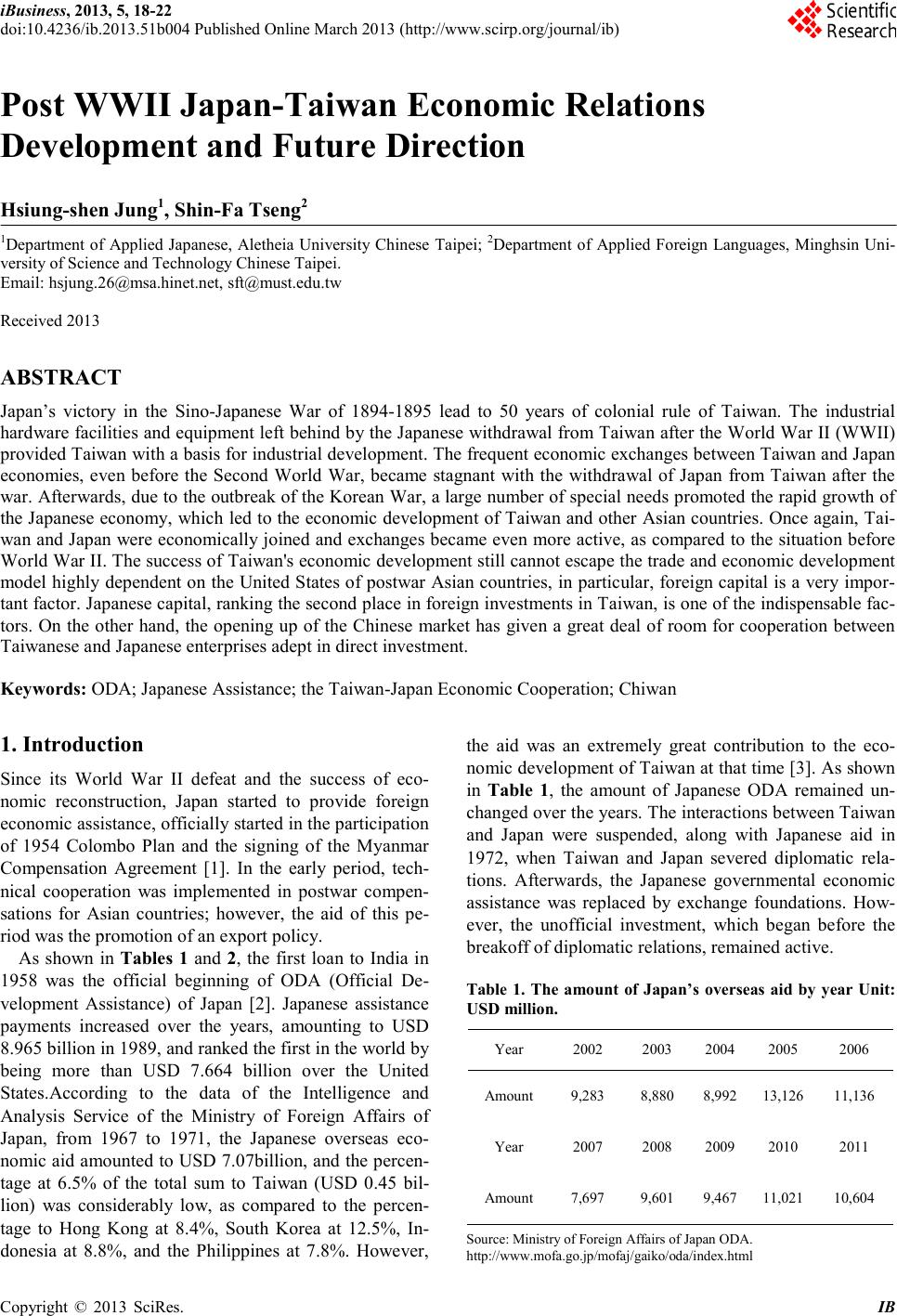 iBusiness, 2013, 5, 18-22 doi:10.4236/ib.2013.51b004 Published Online March 2013 (http://www.scir p.org/journal/ib) Copyright © 2013 SciRes. IB Post WWII Japan-Taiwan E conom ic Relations Developm en t an d Future Direct ion Hsiung-shen Jung1, Shin-Fa Tseng2 1Department of Applied Japanese, Aletheia University Chinese Taipei; 2Department of Applied Foreign Languages, Minghsin Uni- versity of Science and Technology Chinese T aipei. Email: hsjung.26@msa.hinet.net, sft@must.edu.tw Received 2013 ABSTRACT Japan’s victory in the Sino-Japanese War of 1894-1895 lead to 50 years of colonial rule of Taiwan. The industrial hardware facilities and equipment left behind by the Japanese withdrawal from Taiwan after the World War II (WWII) provided Taiwan with a basis for industrial development. The frequent economic exchanges between Taiwan and Japan economies, even before the Second World War, became stagnant with the withdrawal of Japan from Taiwan after the war. Afterwards, due to the outbreak of the Korean War, a large number of special needs promoted the rapid growth of the Japanese economy, which led to the economic development of Taiwan and other Asian countr ies. Onc e again, Tai- wan and Japan were economically joined and exchanges became even more active, as compared to the situation before World War II. The success of T aiwan's economic development still cannot escape the trade and economic development model highly dependent on the United States of postwar Asian countries, in particular, foreign capital is a very impor- tant factor. Japanese capital, ranking the second place in foreign investments in Taiwan, is one of the indispensable fac- tors. On the other hand, the opening up of the Chinese market has given a great deal of room for cooperation between Taiwanese and Japanese enterprises adept in direct investment. Keywords: ODA; Japanese Assistance; the Taiwan-Japan Economic Cooperation; Chiwan 1. Introduction Since its World War II defeat and the success of eco- nomic reconstruction, Japan started to provide foreign economic assistance, officially started in the participation of 1954 Colombo Plan and the signing of the Myanmar Compensation Agreement [1]. In the early period, tech- nical cooperation was implemented in postwar compen- sations for Asian countries; however, the aid of this pe- riod was the promotion of an export policy. As shown in Tables 1 and 2, the first loan to India in 1958 was the official beginning of ODA (Official De- velopment Assistance) of Japan [2]. Japanese assistance payments increased over the years, amounting to USD 8.965 billion in 1989, and ranked the first in the world by being more than USD 7.664 billion over the United States.According to the data of the Intelligence and Analysis Service of the Ministry of Foreign Affairs of Japan, from 1967 to 1971, the Japanese overseas eco- nomic aid amounted to USD 7.07billion, and the percen- tage at 6.5% of the total sum to Taiwan (USD 0.45 bil- lion) was considerably low, as compared to the percen- tage to Hong Kong at 8.4%, South Korea at 12.5%, In- donesia at 8.8%, and the Philippines at 7.8%. However, the aid was an extremely great contribution to the eco- nomic development of Taiwan at that time [ 3] . As sho wn in Table 1, the amount of Japanese ODA remained un- changed over the years. The interactions between Taiwan and Japan were suspended, along with Japanese aid in 1972, when Taiwan and Japan severed diplomatic rela- tions. Afterwards, the Japanese governmental economic assistance was replaced by exchange foundations. How- ever, the unofficial investment, which began before the breakoff of diplomatic relations, remained active. Table 1. The amount of Japan’s overseas aid by year Unit : USD million. Year 2002 2003 2004 2005 2006 Amount 9,283 8,880 8,992 13,126 11,136 Year 2007 2008 2009 2010 2011 Amount 7,697 9,601 9,467 11,021 10,604 Source: Minist ry of Foreign Affairs of Jap an ODA. http://www.mofa.go.jp/mofaj/gaiko/oda/index.html 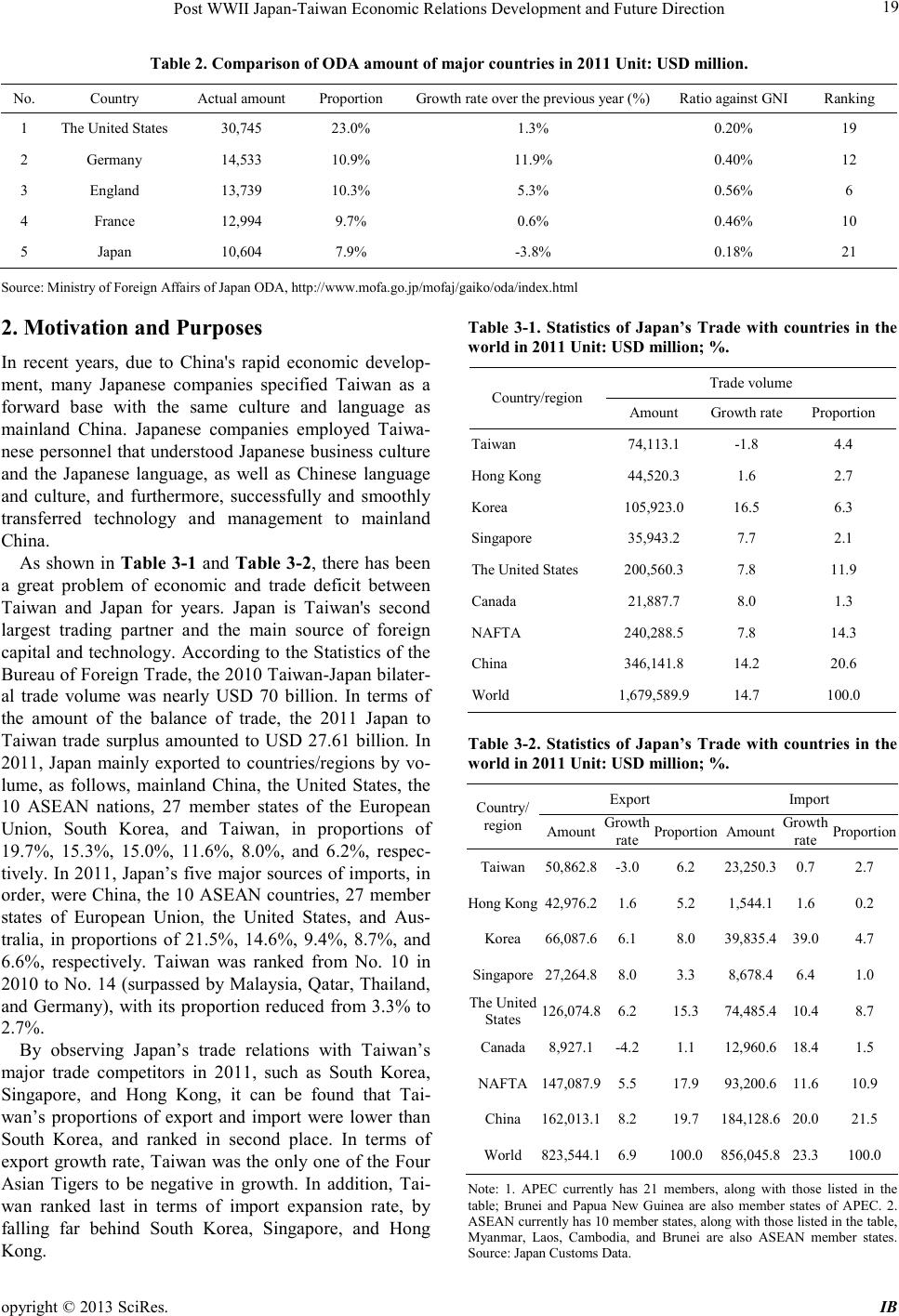 Post WWII Japan-Taiwan E conomic Relations Develo pment and Futu r e D irection opyright © 2013 S ciRes. IB 19 Table 2. Comparison of ODA amount of major countries in 2011 Unit: USD million. No. Country Actual a m ount Pr oportion Growth rate over the previo us yea r (%) Ratio against GNI Ranking 1 The United States 30,745 23.0% 1.3% 0.20% 19 2 Germany 14,533 1 0.9% 11.9% 0.40% 12 3 England 13,739 10.3% 5.3% 0.56% 6 4 France 12,994 9.7% 0.6% 0.46% 10 5 Japan 10,604 7.9% -3.8% 0.18% 21 Source: Ministry of Foreign Affairs of Japan ODA, http://www.mofa.go.jp/mofaj/gaiko/oda/index.html 2. Motivation and Purposes In recent years, due to China's rapid economic develop- ment, many Japanese companies specified Taiwan as a forward base with the same culture and language as mainland China. Japanese companies employed Taiwa- nese p ersonne l that und erstoo d Japane se busines s cultur e and the Japanese language, as well as Chinese language and culture, and furthermore, successfully and smoothly transferred technology and management to mainland China. As sho wn in Table 3-1 and Table 3-2, there has been a great problem of economic and trade deficit between Taiwan and Japan for years. Japan is Taiwan's second largest trading partner and the main source of foreign capital and tec hnology. According to t he Statistics of the Bureau of Foreign Trade, the 2010 Taiwan-Japan bilater- al trade volume was nearly USD 70 billion. In terms of the amount of the balance of trade, the 2011 Japan to Taiwan trade surplus amounted to USD 27.61 billion. In 2011, Japan mainly exported to countries/regions by vo- lume, as follows, mainland China, the United States, the 10 ASEAN nations, 27 member states of the European Union, South Korea, and Taiwan, in proportions of 19.7%, 15.3%, 15.0%, 11.6%, 8.0%, and 6.2%, respec- tively. In 2011, Japan’s five major sources of imports, in order, were China, the 10 ASEAN countries, 27 member states of European Union, the United States, and Aus- tralia, in proportions of 21.5%, 14.6%, 9.4%, 8.7%, and 6.6%, respectively. Taiwan was ranked from No. 10 in 2010 to No. 14 (surpassed by Malaysia, Qatar, Thailand, and Germany), with its proportion reduced from 3.3% to 2.7%. By observing Japan’s trade relations with Taiwan’s major trade competitors in 2011, such as South Korea, Singapore, and Hong Kong, it can be found that Tai- wan’s proportions of export and import were lower than South Korea, and ranked in second place. In terms of expo rt gro wth rat e, Tai wan was the o nly one o f the Fo ur Asian Tigers to be negative in growth. In addition, Tai- wan ranked last in terms of import expansion rate, by falling far behind South Korea, Singapore, and Hong Kong. Table 3-1. Statistics of Japan’s Trade with countries in the world in 2011 Unit: USD million; %. Country/region Trade volum e Amount Gro wth ra te Proportion Taiwan 74,113.1 -1.8 4.4 Hong Kong 44,520.3 1.6 2.7 Kor ea 105,923.0 16.5 6.3 Singapore 35,943.2 7.7 2.1 The United States 200,560.3 7.8 11.9 Canada 21,887.7 8.0 1.3 NAFTA 240,288.5 7.8 14.3 China 346,141.8 14.2 20.6 Wor ld 1,679,589.9 14.7 100.0 Table 3-2. Statistics of Japan’s Trade with countries in the world in 2011 Unit: USD million; %. Country/ region Export Im p or t Amount Growth rate Proportion Amount Growt h rate Proportion Taiwan 50,862.8 -3.0 6.2 23,250.3 0.7 2.7 Hong Kong 42,976.2 1.6 5.2 1,544.1 1.6 0.2 Kor ea 66,087.6 6.1 8.0 39,835.4 39.0 4.7 Singapore 27,264.8 8.0 3.3 8,678.4 6.4 1.0 The United States 126,07 4.8 6.2 15.3 74,485.4 10.4 8.7 Canada 8,927.1 -4.2 1.1 12,960.6 18.4 1.5 NAFTA 147,087.9 5.5 17.9 93,200.6 11.6 10.9 China 162,013.1 8.2 19.7 184,128.6 20.0 21.5 Wor ld 823,544.1 6.9 100.0 856,045.8 23.3 100.0 Note: 1. APEC currently has 21 members, along with those listed in the table; Brunei and Papua New Guinea are also member states of APEC. 2. ASEAN currently has 10 member stat es, along with those lis ted in the table, Myanmar, Laos, Cambodia, and Brunei are also ASEAN member states. Source: Japan Customs Data. 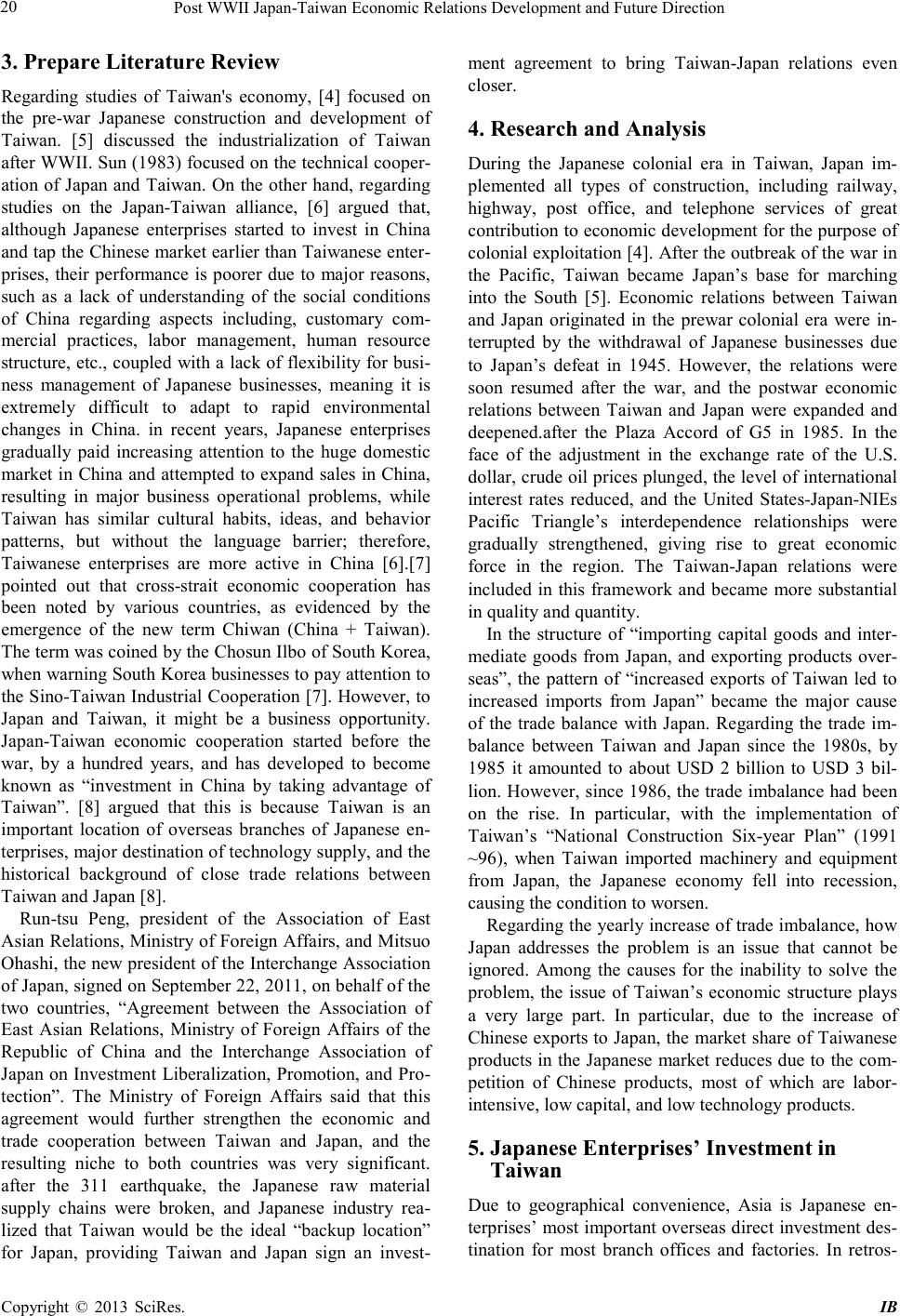 Post WWII Japan-Taiwan E conomic Relations Development and Future Direction Copyright © 2013 SciRes. IB 20 3. Prepare Literature Review Regarding studies of Taiwan's economy, [4] focused on the pre-war Japanese construction and development of Taiwan. [5] discussed the industrialization of Taiwan after WWII. Sun (1983) focused on the technical cooper- ation of Japan and Taiwan. On the other hand, regarding studies on the Japan-Taiwan alliance, [6] argued that, although Japanese enterprises started to invest in China and tap the Chinese market earlier than Taiwanese enter- prises, their performance is poorer due to major reasons, such as a lack of understanding of the social conditions of China regarding aspects including, customary com- mercial practices, labor management, human resource structure, etc., coupled with a lack of flexibility for busi- ness management of Japanese businesses, meaning it is extremely difficult to adapt to rapid environmental changes in China. in recent years, Japanese enterprises gradually paid increasing attention to the huge domestic market in Chi na and atte mpted to expand sales in China, resulting in major business operational problems, while Taiwan has similar cultural habits, ideas, and behavior patterns, but without the language barrier; therefore, Taiwanese enterprises are more active in China [6].[7] pointed out that cross-strait economic cooperation has been noted by various countries, as evidenced by the emergence of the new term Chiwan (China + Taiwan). The term was coined by the Chosun Ilbo of South Korea, whe n warni ng So uth K ore a busi nes ses to pay attention to the S ino-Taiwan Industrial Cooperation [7]. However, to Japan and Taiwan, it might be a business opportunity. Japan-Taiwan economic cooperation started before the war, by a hundred years, and has developed to become known as “investment in China by taking advantage of Taiwan”. [8] argued that this is because Taiwan is an important location of overseas branches of Japanese en- terprises, major destination of technology supply, and the historical background of close trade relations between Taiwan and Japan [8]. Run-tsu Peng, president of the Association of East Asian Relation s, Ministry of Foreign A ffairs, and Mitsuo Ohas hi, the ne w pres ident o f the Int ercha nge As sociat ion of Japan, signed on September 22, 2011, on behalf of the two countries, “Agreement between the Association of East Asian Relations, Ministry of Foreign Affairs of the Republic of China and the Interchange Association of Japan on Investment Liberalization, Promotion, and Pro- tection”. The Ministry of Foreign Affairs said that this agreement would further strengthen the economic and trade cooperation between Taiwan and Japan, and the resulting niche to both countries was very significant. after the 311 earthquake, the Japanese raw material supply chains were broken, and Japanese industry rea- lized that Taiwan would be the ideal “backup location” for Japan, providing Taiwan and Japan sign an invest- ment agreement to bring Taiwan-Japan relations even closer. 4. Research and Analysis During the Japanese colonial era in Taiwan, Japan im- plemented all types of construction, including railway, highway, post office, and telephone services of great contribution to economic development for the purpose of colonial explo itation [4 ]. Afte r the o utbreak o f the war i n the Pacific, Taiwan became Japan’s base for marching into the South [5]. Economic relations between Taiwan and Japan originated in the prewar colonial era were in- terrupted by the withdrawal of Japanese businesses due to Japan’s defeat in 1945. However, the relations were soon resumed after the war, and the postwar economic relations between Taiwan and Japan were expanded and deepened.after the Plaza Accord of G5 in 1985. In the face of the adjustment in the exchange rate of the U.S. dollar, crude oil prices p lunged, the le vel of international interest rates reduced, and the United States-Japan-NIEs Pacific Triangle’s interdependence relationships were gradually strengthened, giving rise to great economic force in the region. The Taiwan-Japan relations were included in this framework and became more substantial in qualit y and quantity. In the structure of “importing capital goods and inter- mediate goods from Japan, and exporting products over- seas”, the pattern of “increased exports of Taiwan led to increased imports from Japan” became the major cause of the trade balance with Japan. Regarding the trade im- balance between Taiwan and Japan since the 1980s, by 1985 it amounted to about USD 2 billion to USD 3 bil- lion. However, since 1986, the trade imbalance had been on the rise. In particular, with the implementation of Taiwan’s “National Construction Six-year Plan” (1991 ~96), when Taiwan imported machinery and equipment from Japan, the Japanese economy fell into recession, causing t he co ndition to worsen. Regarding the yearly increase of trade imbalance, how Japan addresses the problem is an issue that cannot be ignored. Among the causes for the inability to solve the problem, the issue of Taiwan’s economic structure plays a very large part. In particular, due to the increase of Chinese exports to Japan, the market share of Taiwanese products in the Japanese market reduces due to the com- petition of Chinese products, most of which are labor- intensive, low capital, and low technology p r oducts. 5. Japanese Enterprises’ Investment in Taiwan Due to geographical convenience, Asia is Japanese en- terprises’ most i mportant over seas direct investment des- tination for most branch offices and factories. In retros - 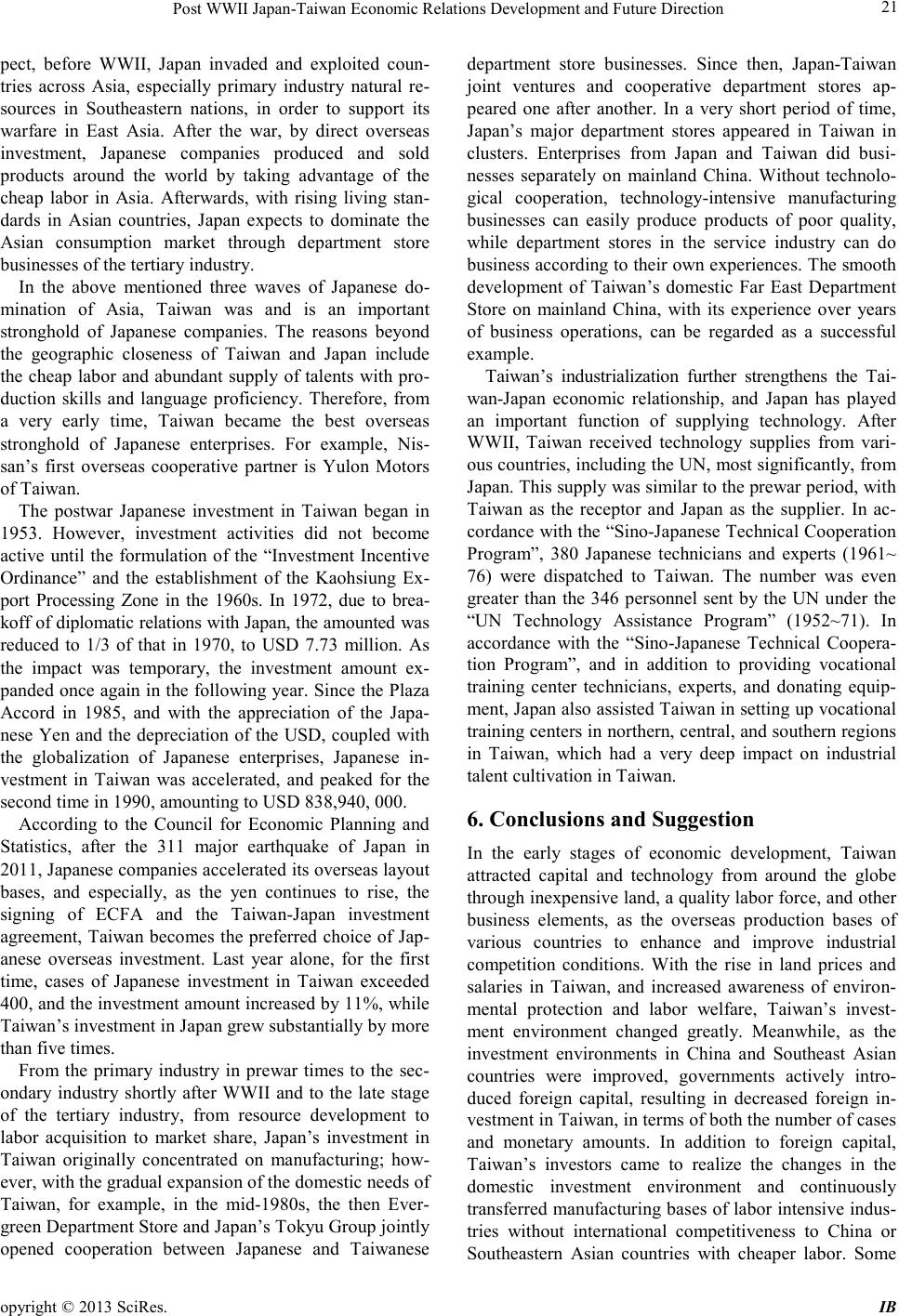 Post WWII Japan-Taiwan E conomic Relations Develo pment and Futu r e D irection opyright © 2013 S ciRes. IB 21 pect, before WWII, Japan invaded and exploited coun- tries across Asia, especially primary industry natural re- sources in Southeastern nations, in order to support its warfare in East Asia. After the war, by direct overseas investment, Japanese companies produced and sold products around the world by taking advantage of the cheap labor in Asia. Afterwards, with rising living stan- dards in Asian countries, Japan expects to dominate the Asian consumption market through department store busine sses o f the tertiary industry. In the above mentioned three waves of Japanese do- mination of Asia, Taiwan was and is an important stronghold of Japanese companies. The reasons beyond the geographic closeness of Taiwan and Japan include the cheap labor and abundant suppl y of talent s with pro- duction skills and language proficiency. Therefore, from a very early time, Taiwan became the best overseas stronghold of Japanese enterprises. For example, Nis- san’s first overseas cooperative partner is Yulon Motors of Taiwan. The postwar Japanese investment in Taiwan began in 1953. However, investment activities did not become active until the formulation of the “Investment Incentive Ordinance” and the establishment of the Kaohsiung Ex- port Processing Zone in the 1960s. In 1972, due to brea- koff of d iplomati c relation s with Jap an, the a mounted was reduced to 1/3 of that in 1970, to USD 7.73 million. As the impact was temporary, the investment amount ex- panded once again in the following year. Since the Plaza Accord in 1985, and with the appreciation of the Japa- nese Yen and the depreciation of the USD, coupled with the globalization of Japanese enterprises, Japanese in- vestment in Taiwan was accelerated, and peaked for the second time in 1990, amounting to USD 838,940, 000. According to the Council for Economic Planning and Statistics, after the 311 major earthquake of Japan in 2011, Japanese companies accelerated its overseas layout bases, and especially, as the yen continues to rise, the signing of ECFA and the Taiwan-Japan investment agreement, Taiwan becomes the preferred choice of Jap- anese overseas investment. Last year alone, for the first time, cases of Japanese investment in Taiwan exceeded 400, and the investment amo unt increased by 11%, while Ta iwan ’s i nvest me nt i n J a p an gr e w sub s tanti al ly by mor e than five t imes . From the primary industry in prewar times to the sec- ondary industry shortly after WWII and to the late stage of the tertiary industry, from resource development to labor acquisition to market share, Japan’s investment in Taiwan originally concentrated on manufacturing; how- ever , with t he gradual expa nsion o f the domestic needs of Taiwan, for example, in the mid-1980s, the then Ever- gree n De pa r t ment S to r e a nd J a p an’ s To kyu Gr o up jo intl y opened cooperation between Japanese and Taiwanese department store businesses. Since then, Japan-Taiwan joint ventures and cooperative department stores ap- peared one after another. In a very short period of time, Japan’s major department stores appeared in Taiwan in clusters. Enterprises from Japan and Taiwan did busi- nesses separately on mainland China. Without technolo- gical cooperation, technology-intensive manufacturing businesses can easily produce products of poor quality, while department stores in the service industry can do busi ness acc ordi ng to their own exp erie nces. The smoo th development of Taiwan’s domestic Far East Department Store on mainland China, with its experience over years of business operations, can be regarded as a successful example. Taiwan’s industrialization further strengthens the Tai- wan-Japan economic relationship, and Japan has played an important function of supplying technology. After WWII, Taiwan received technology supplies from vari- ous countries, including the UN, most significantly, from Japan. This supply was similar to the prewar period, with Taiwan as the receptor and Japan as the supplier. In ac- cordance with the “Sino -Japanese Technical Cooperation Program”, 380 Japanese technicians and experts (1961~ 76) were dispatched to Taiwan. The number was even greater than the 346 personnel sent by the UN under the “UN Technology Assistance Program” (1952~71). In accordance with the “Sino-Japanese Technical Coopera- tion Program”, and in addition to providing vocational training center technicians, experts, and donating equip- ment, Japan also assisted Taiwan in setting up vocational trai ning c ente rs i n no rthe rn, c ent ral, and s out her n reg ion s in Taiwan, which had a very deep impact on industrial talent cultivatio n in Taiwan. 6. Conclusions and Suggestion In the early stages of economic development, Taiwan attracted capital and technology from around the globe thro ugh i nexpensive land, a quality labor force, and other business elements, as the overseas production bases of various countries to enhance and improve industrial competition conditions. With the rise in land prices and salaries in Taiwan, and increased awareness of environ- mental protection and labor welfare, Taiwan’s invest- ment environment changed greatly. Meanwhile, as the investment environments in China and Southeast Asian countries were improved, governments actively intro- duced foreign capital, resulting in decreased foreign in- vest me nt i n Ta i wan, i n te r ms o f b ot h the nu mb er o f ca se s and monetary amounts. In addition to foreign capital, Taiwan’s investors came to realize the changes in the domestic investment environment and continuously transferred manufacturing b ases of labo r intensi ve indus- tries without international competitiveness to China or Southeastern Asian countries with cheaper labor. Some 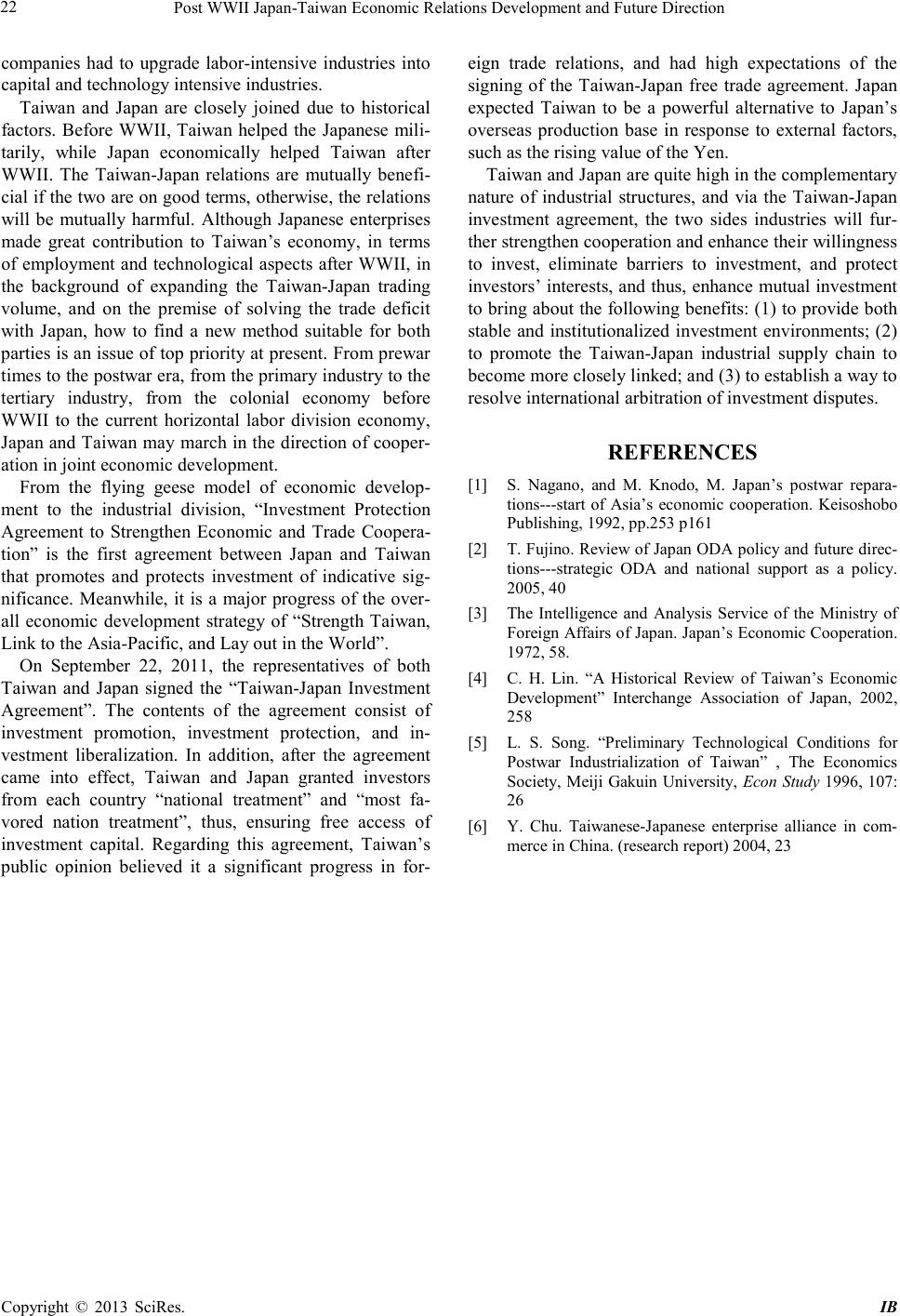 Post WWII Japan-Taiwan E conomic Relations Development and Future Direction Copyright © 2013 SciRes. IB 22 companies had to upgrade labor-intensive industries into capital and tec hnology inte nsive industries. Taiwan and Japan are closely joined due to historical factors. Before WWII, Taiwan helped the Japanese mili- tarily, while Japan economically helped Taiwan after WWII. The Taiwan-Japan relations are mutually benefi- cial if the two are on good terms, otherwise, the relations will be mutually harmful. Although Japanese enterprises made great contribution to Taiwan’s economy, in terms of employment and technological aspects after WWII, in the background of expanding the Taiwan-Japan trading volume, and on the premise of solving the trade deficit with Japan, how to find a new method suitable for both parties is an issue of top priority at present. From prewar times to the postwar era, fro m the primary industry to the tertiary industry, from the colonial economy before WWII to the current horizontal labor division economy, Japan and Taiwan may march in the direction of cooper- ation in joint eco nomic development. From the flying geese model of economic develop- ment to the industrial division, “Investment Protection Agreement to Strengthen Economic and Trade Coopera- tion” is the first agreement between Japan and Taiwan that promotes and protects investment of indicative sig- nificance. Meanwhile, it is a major progress of the over- all economic development strategy of “Strength Taiwan, Link to the Asia-Pacific, and Lay out in the World ” . On September 22, 2011, the representatives of both Taiwan and Japan signed the “Taiwan-Japan Investment Agreement”. The contents of the agreement consist of investment promotion, investment protection, and in- vestment liberalization. In addition, after the agreement came into effect, Taiwan and Japan granted investors from each country “national treatment” and “most fa- vored nation treatment”, thus, ensuring free access of investment capital. Regarding this agreement, Taiwan’s public opinion believed it a significant progress in for- eign trade relations, and had high expectations of the signing of the Taiwan-Japan free trade agreement. Japan expected Taiwan to be a powerful alternative to Japan’s overseas production base in response to external factors, such as the rising value of the Yen. Taiwan and Japan are quite high in the complementary nature of industrial structures, and via the Taiwan-Japan investment agreement, the two sides industries will fur- ther strengthen cooperation and enhance their willingness to invest, eliminate barriers to investment, and protect inves tors’ int erests, and thus, enhanc e mutual i nvest ment to bring abo ut the following benefits: (1 ) to provide both stable and institutionalized investment environments; (2) to promote the Taiwan-Japan industrial supply chain to become more closely linked; and (3) to establish a way to resolve inter national arb itration of inve stment disputes. REFERENCES [1] S. Nagano, and M. Knodo, M. Japan’s postwar repara- tions---start of Asia’s economic cooperation. Keisoshobo Publis hing , 1992, pp. 25 3 p161 [2] T. Fujino. Review of Japan ODA policy and future direc- tions---strategic ODA and national support as a policy. 2005, 40 [3] The Intelligence and Analysis Service of the Ministry of Foreign Affairs of Japan. Japan’s Economic Cooperation. 1972, 58 . [4] C. H. Lin. “A Historical Review of Taiwan’s Economic Development” Interchange Association of Japan, 2002, 258 [5] L. S. Song. “Preliminary Technological Conditions for Postwar Industrialization of Taiwan” , The Economics Society, Meiji Gakuin University, Econ Study 1996, 107: 26 [6] Y. Chu. Taiwanese-Japanese enterprise alliance in com- merce in China. (research r eport) 20 04, 23 |

